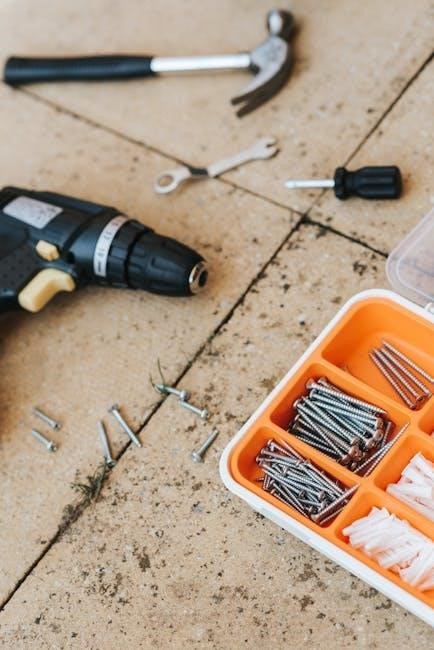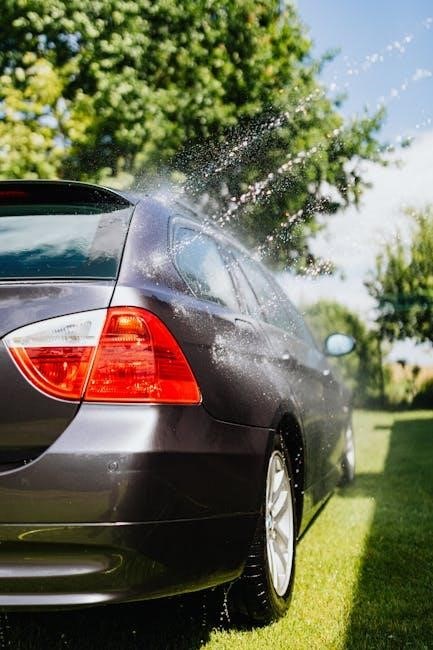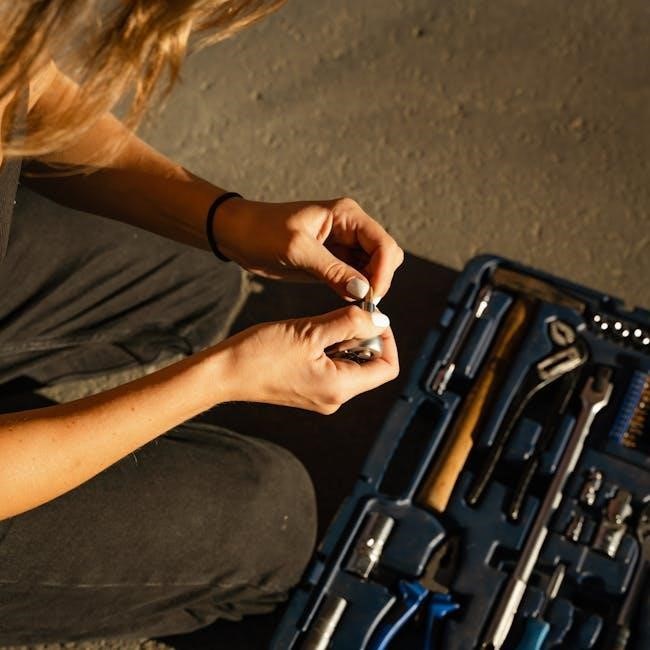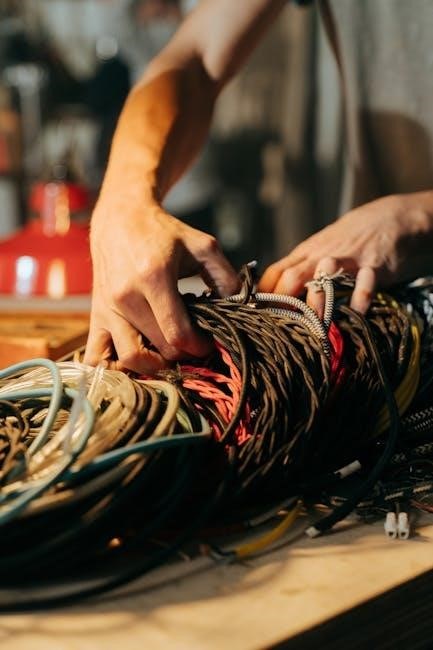Cessna 310Q Maintenance Manual: A Comprehensive Guide
The Cessna 310Q maintenance manual serves as a crucial resource for owners and operators․ It provides detailed instructions for servicing, inspection, and repair, ensuring the aircraft’s continued airworthiness and safe operation․ Parts catalogs, service bulletins and manuals are available․
The Cessna 310Q, a variant of the popular 310 series, is a twin-engine aircraft known for its performance and reliability․ Produced between 1969 and 1974, it holds a significant place in aviation history․ This manual is specifically tailored to the 310Q model․ It provides essential maintenance information․ Proper maintenance is vital for the continued safe and efficient operation of the aircraft․
Owners and operators must adhere to the guidelines outlined in this manual․ Regular inspections, servicing, and adherence to maintenance schedules are crucial․ Accessing resources like parts catalogs and service bulletins further enhances maintenance efforts․ The Cessna 310Q Maintenance Manual is a key tool for preserving the aircraft’s integrity․

Applicability of Manuals
Understanding which manual applies to your specific Cessna 310 variant is critical․ Manuals are tailored to specific production years and models․ Using the correct manual ensures accurate maintenance procedures and part identification for your aircraft․
Cessna 310P and 310Q (1969-1974) Service Manual
This service manual specifically addresses the Cessna 310P and 310Q models manufactured between 1969 and 1974․ It’s a comprehensive guide, spanning over 950 pages and last updated in April 2011, providing detailed information on aircraft systems, maintenance procedures, and troubleshooting․ The manual covers airframe, engine, landing gear, and other essential components․ Technicians rely on this document for proper servicing and repair, ensuring the aircraft meets safety standards․ It includes sections on ground handling, servicing, inspection, airframe maintenance, landing gear, and control systems․ Access to this manual is vital for maintaining the 310P and 310Q models․
Cessna 310R and T310R (1975-1981) Maintenance Manual

The Cessna 310R and T310R maintenance manual caters to models produced from 1975 to 1981․ This manual offers detailed maintenance procedures specific to these later variants, including differences in systems and components compared to earlier models․ Technicians use this manual for comprehensive servicing and repair․ It contains vital information for ensuring the continued airworthiness of these aircraft․ Key areas covered include airframe, engine, avionics, and other crucial systems․ The manual also provides troubleshooting guides and inspection checklists․ It is an essential resource for aircraft maintenance personnel working on the 310R and T310R models, enabling them to perform maintenance tasks effectively and safely․

Key Sections in the Service Manual
The Cessna 310Q service manual is divided into key sections, each addressing specific areas of aircraft maintenance․ These sections include ground handling, airframe maintenance, landing gear, and control systems, ensuring comprehensive coverage․
Ground Handling, Servicing & Inspection
This section of the Cessna 310Q service manual covers essential procedures for safely handling the aircraft on the ground․ It includes instructions for towing, parking, and securing the aircraft․ Proper servicing techniques, such as refueling and fluid checks, are detailed to maintain optimal performance․ Regular inspections are crucial for identifying potential issues early on․
The manual provides checklists and guidelines for conducting thorough inspections of various components․ These inspections help ensure the aircraft is in airworthy condition before each flight․ Addressing any identified discrepancies promptly prevents further damage and enhances safety․ This section emphasizes the importance of adhering to recommended servicing schedules and inspection intervals․
Airframe Maintenance
The airframe maintenance section of the Cessna 310Q service manual focuses on the structural integrity and upkeep of the aircraft․ It provides detailed procedures for inspecting and repairing the fuselage, wings, and empennage․ This section covers topics such as corrosion control, skin repair, and structural component replacement․ Proper riveting techniques and sealant application are emphasized․
The manual includes diagrams and illustrations to aid in understanding the airframe’s construction․ Regular inspections are crucial for detecting cracks, dents, or other damage that could compromise the aircraft’s safety․ This section highlights the importance of adhering to manufacturer specifications and using approved materials for all repairs and replacements․
Landing Gear & Brake System
This section of the Cessna 310Q maintenance manual details the inspection, maintenance, and repair of the landing gear and brake system․ It covers components such as the nose gear, main landing gear, struts, wheels, tires, and brakes․ Detailed instructions are provided for lubricating moving parts, checking for wear and tear, and replacing worn components․
Proper brake system maintenance is crucial for safe landings․ The manual includes procedures for bleeding the brakes, inspecting brake lines, and replacing brake pads․ Torque specifications for all fasteners are provided to ensure proper assembly․ Regular inspections are essential to identify potential problems before they lead to system failure․
Control Column, Aileron & Related Systems
The control column, ailerons, and related systems are critical for controlling the aircraft’s roll․ This section of the Cessna 310Q maintenance manual provides detailed instructions for inspecting, maintaining, and repairing these systems․ It covers the control column, control cables, pulleys, bellcranks, and ailerons themselves․
Proper cable tension is crucial for smooth and responsive control․ The manual specifies the correct tension for each cable and provides instructions for adjusting it․ Regular lubrication of moving parts is also essential to prevent wear and corrosion․ Any signs of damage or wear should be addressed promptly to ensure safe flight operations and optimal aircraft performance․

Important Maintenance Procedures
Several key maintenance procedures are vital for the Cessna 310Q․ These include nose gear uplock torque tube inspections, nose gear steering mechanism checks, and torque links inspections․ Adhering to these procedures ensures aircraft safety and reliability․

Nose Gear Uplock Torque Tube Inspection
The nose gear uplock torque tube is a critical component, and its inspection is paramount for the Cessna 310Q․ This inspection should involve a dye check, as specified in temporary revision number 10, dated February 22, 2010, from Cessna Aircraft Company․ The purpose is to identify any potential cracks or weaknesses in the torque tube that could compromise the landing gear’s integrity; Early detection of such issues ensures timely repairs, preventing possible in-flight failures or landing incidents․ This proactive approach is essential for maintaining the aircraft’s safety and operational reliability․ Proper inspection prevents damages or failures․
Nose Gear Steering Mechanism Check
A thorough check of the nose gear steering mechanism is vital for Cessna 310Q maintenance․ This procedure involves carefully examining the cables and bearings for any signs of wear, damage, or improper function․ Ensure the cables are correctly tensioned and free from fraying or corrosion․ The bearings should be inspected for smooth operation and proper lubrication․ Any issues detected must be addressed promptly to maintain precise and reliable steering control during taxiing and landing․ Regular inspections prevent potential steering failures, enhancing ground safety․ Also ensure proper torque to all screws, bolts and nuts for safety․
Torque Links Inspection
Regular inspection of the torque links on the Cessna 310Q’s landing gear is crucial for maintaining structural integrity and ensuring safe operation․ The inspection should focus on identifying any signs of damage, wear, or corrosion on the links themselves․ Pay close attention to the washers and the areas where the torque links contact the washers, checking for deformation or cracks․ Any detected damage must be addressed immediately through repair or replacement․ Proper maintenance of torque links is essential for preventing landing gear failures and ensuring the aircraft’s continued airworthiness․ It is important to torque all the bolts as specified․

Accessing Maintenance Information
Owners can use the Cessna 310/320 Maintenance Library to access crucial service manuals․ This library also includes illustrated parts catalogs, operating instructions, and service information which is all vital for proper maintenance․
Cessna 310/320 Maintenance Library
The Cessna 310/320 Maintenance Library is an invaluable resource for owners and maintenance personnel․ It offers a centralized location to access critical documentation required for maintaining these aircraft․ This library typically includes service manuals, which provide detailed instructions for inspection, repair, and overhaul procedures․ Illustrated parts catalogs are also included to aid in identifying and ordering the correct replacement components․ Furthermore, the library usually contains operating instructions, service letters, and service bulletins․ These resources are essential for understanding proper operating procedures and staying up-to-date with the latest maintenance recommendations and airworthiness directives․ Accessing this comprehensive library can significantly improve maintenance efficiency and ensure the safe operation of Cessna 310/320 aircraft․

Additional Resources
Beyond the core maintenance manual, operators benefit from parts catalogs for identifying components․ Service information and bulletins provide updates on maintenance procedures․ These resources aid comprehensive aircraft upkeep and regulatory compliance․
Parts Catalogs
Locating the correct replacement parts is crucial for maintaining a Cessna 310Q․ Parts catalogs are essential resources that provide detailed illustrations and part numbers for every component of the aircraft․ These catalogs enable mechanics and owners to identify and order the specific parts needed for repairs or maintenance․
Having the correct part number ensures compatibility and proper fit, preventing potential safety hazards․ Parts catalogs often include exploded views, making it easier to understand the assembly and disassembly of various systems․ They are invaluable for both routine maintenance and complex repairs, contributing to the aircraft’s longevity and safety․ Accessing these resources streamlines the maintenance process․
Service Information and Bulletins
Staying up-to-date with the latest service information and bulletins is critical for maintaining a Cessna 310Q to the highest standards․ These documents provide essential updates, modifications, and safety directives from the manufacturer․ Service bulletins address potential issues, recommend inspections, and outline necessary repairs or upgrades․
Regularly reviewing these bulletins ensures that the aircraft complies with the latest safety regulations and performance enhancements; Ignoring service information can lead to undetected problems, compromising safety and potentially reducing the aircraft’s lifespan․ Accessing and implementing service bulletins is a proactive approach to maintaining a reliable and safe Cessna 310Q, safeguarding both the aircraft and its occupants․

Considerations for Owners and Operators
Owning and operating a Cessna 310Q requires careful consideration of maintenance costs, inspection procedures, and operational tips․ Utilizing available manuals and resources will ensure safe and efficient aircraft operation for years to come․

Operating Costs of a Cessna 310Q
Understanding the operating costs of a Cessna 310Q is crucial for prospective and current owners․ These costs encompass a range of factors, including fuel consumption, maintenance, insurance, and hangar fees․ Fuel costs are a significant variable, influenced by fuel prices and flight hours․ Maintenance expenses include routine inspections, repairs, and component overhauls, as detailed in the maintenance manual․
Insurance premiums vary based on coverage and pilot experience․ Hangar fees depend on location and facility amenities; Accurately estimating these costs is vital for budgeting and ensuring the long-term financial viability of owning and operating a Cessna 310Q․ Owners can consult resources to obtain realistic estimates․
Inspection and Maintenance Tips
Regular inspections are paramount for maintaining the airworthiness of a Cessna 310Q․ Adhering to the maintenance schedule outlined in the service manual is essential․ Pay close attention to critical areas such as the landing gear, control surfaces, and engine components․ Torque links and steering mechanisms should be checked․
Carefully inspect for signs of corrosion, wear, or damage, addressing any issues promptly․ Utilize the Cessna 310/320 maintenance library for guidance․ Keep detailed maintenance records to track inspections, repairs, and component replacements․ Proactive maintenance helps prevent costly repairs and ensures the safe and reliable operation of your Cessna 310Q․
